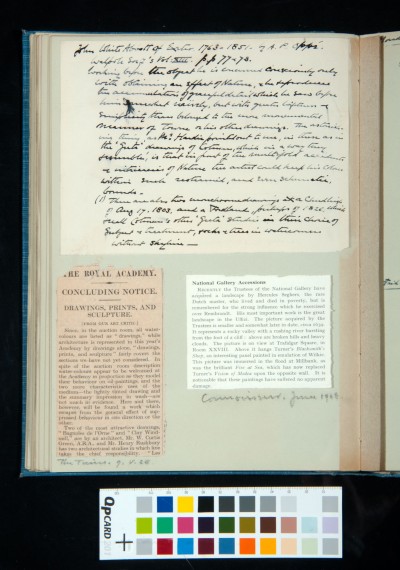Cotmania. Vol. II. 1927-8
Archive: SDK Sydney Decimus Kitson Archive
Reference Number: SDK/1/2/1/2
Page: 40 verso
-
Description
Article on J.W. Abbott by Oppé / Drawings at the Royal Academy / Seghers and Turner at the National Gallery
article transcribed by Kitson / newspaper cutting / magazine cutting
Date: 09 May 1928 - 30 June 1928
-
Transcription
{article transcribed by Kitson}
John White Abbott of Exeter. 1763-1851. by A. P. Oppé
Walpole Society's Vol: 13 p.p 77 & 78
Working before the object he is concerned consciously only with obtaining an effect of Nature, & he reproduces the accumulation of graceful detail which he saw before him somewhat naïvely, but with greater lightness & simplicity than belonged to the more monumental manner of Towne or his other drawings. The astonishing thing, as Mr Hardie pointed out to me, in these as in the 'Greta' drawings of Cotman, which in a way they resemble, is that in front of the multifold accidents & intricacies of Nature the artist could keep his colour within such restrained, and even schematic, bounds.
(1) There are also two monochrome drawings [[at]] a Chudleigh of Aug 17, 1803, and a [Fordland?], perhaps of 1826, which recall Cotman's other 'Greta' studies in their choice of Subject & treatment, rocks & trees in watercourses without skyline -/
{newspaper cutting}
THE ROYAL ACADEMY.
CONCLUDING NOTICE.
DRAWINGS, PRINTS, AND SCULPTURE.
(FROM OUR ART CRITIC.)
Since, in the auction room, all water-colours are listed as "drawings," while architecture is represented in this year's Academy by drawings alone, "drawings, prints, and sculpture" fairly covers the sections we have not yet considered. In spite of the auction room description water-colours appear to be welcomed at the Academy in proportion as they model their behaviour on oil-paintings, and the two more characteristic uses of the medium - the lightly tinted drawing and the summary impression in wash - are not much in evidence. Here and there, however, will be found a work which escapes from the general effect of suppressed behaviour in one direction or the other.
Two of the most attractive drawings, "Bagnoles de l'Orne" and "Clay Windmill," are by an architect, Mr. W. Curtis Green, A.R.A., and Mr. Henry Rushbury has two architectural studies in which line takes the chief responsibility. "Les
<The Times 9.5.28>/
{magazine cutting}
National Gallery Accessions
RECENTLY the Trustees of the National Gallery have acquired a landscape by Hercules Seghers, the rare Dutch master, who lived and died in poverty, but is remembered for the strong influence which he exercised over Rembrandt. His most important work is the great landscape in the Uffizi. The picture acquired by the Trustees is smaller and somewhat later in date, circa 1639. It represents a rocky valley with a rushing river bursting from the foot of a cliff : above are broken hills and heavy clouds. The picture is on view at Trafalgar Square, Room 28. Above it hangs Turner's Blacksmith's Shop, an interesting panel painted in emulation of Wilkie. This picture was immersed in the flood at Millbank, as was the brilliant Fire at Sea, which has now replaced Turner's Vision of Medea upon the opposite wall. It is noticeable that these paintings have suffered no apparent damage.
<Connoisseur, June 1928>
